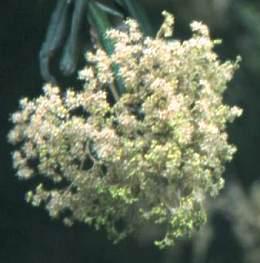Buddleja saligna
Buddleja saligna Willd.
Family: Scrophulariaceae
Common names: false olive (English); witolien (Afrikaans); umBatacwepe (Siswati); lelothwane (South Sotho); mothlware (Tswana); unGqeba (Xhosa); iGqeba-elimhlope (Zulu)
SA Tree No: 636
Introduction
Buddleja saligna is a tree up to 10 m tall in warm moist areas but usually 4 to 5 metres in Highveld areas.

Description
Description
The false olive's young stems are four angled and covered with white velvety hairs. The older stems and trunks are creamy or grey to dark brown and fluted with the bark peeling in longitudinal strips.
The leaves are long and narrow - somewhat similar to the olive from which it gets its common name - but more textured. The leaf upper surface is hairless and dark green, the underside is whitish with prominently raised venation. The flowers are tiny, creamy white and borne in dense sprays usually at the ends of branches. The flowers have a lovely honey scent and appear from spring to summer (August- January). The seeds are minute, forming in small, hairy capsules which develop in the dried out flowers. (October - March)
Distribution and habitat
Distribution description
The false olive is widespread in South Africa, from the Western Cape through to Zimbabwe, extending inland from the coast to central South Africa and the Kalahari thornveld in the northwest. The habitats are very varied. It is found growing on dry hillsides, in mixed scrub, wooded valleys, forest margins, along streams and in coastal bush.
Derivation of name and historical aspects
History
The genus was named in honour of an amateur botanist Rev Adam Buddle (1660-1715). Saligna is a reference to the leaves being willow like.
Uses
Use
The plant is used for traditional medicinal purposes, the roots as a purgative and the leaves to treat coughs and colds. The wood is very fine grained and was used to make small pieces of furniture. The straight branches were used to make fence posts. The false olive was used to make asseggai handles. It also makes good fuel wood as it burns with an intense heat. The large amounts of pollen and nectar it produces makes it popular with bee farmers.

Growing Buddleja saligna
Grow
This fast growing tree is an excellent, quick screen plant. It grows up to 800mm per year. Use it as a pioneer tree for your forest garden. It also makes a very good clipped hedge. There is a fine example of a hedge in the Waterwise Garden at the Witwatersrand National Botanical Garden. It is evergreen, frost hardy and drought resistant and the masses of flowers make a lovely spring and summer show. It will grow in most soils but added compost will improve performance. It may need cutting back after flowering to keep tidy. The false olive does not have an aggressive root system.
The flowers attract insects (especially moths) and therefore insect feeding birds such as robins and apalises to the garden.
Buddleja saligna is easily grown from seed or cuttings. The seed is very fine and should be mixed with sand to obtain an even distribution. Sow in a good, fine seedling mix in seedling trays. To water after sowing, stand the tray in a clean, shallow container of water and allow to soak up into seed tray. Remove once the surface is wet. Germination may not take place all at the same time although most seed should have germinated after four weeks. Transplant into black bags, taking care to water well afterwards.
References
- Joffe, P. 2001. Creative Gardening with Indigenous Plants: A South African Guide. Briza. Pretoria
- Palmer, E and Pitman, N. 1972. Trees of Southern Africa: Volume 3. A.A. Balkema. Cape Town.
- Thomas, V and Grant, R. 1998. Sappi Tree Spotting, Highveld and the Drakensberg. Jacana Education. Johannesburg.
- Venter, F and J-A. 1996. Making the most of Indigenous Trees. Briza Publications. Pretoria.
- Van Wyk, B and van Wyk, P. 1997. Field Guide to Trees of Southern Africa. Struik Publishers. Cape Town.
Credits
Alice Aubrey
Walter Sisulu National Botanical Garden
January 2002
Plant Attributes:
Plant Type: Tree
SA Distribution: Eastern Cape, Free State, Gauteng, KwaZulu-Natal, Limpopo, Mpumalanga, North West, Northern Cape, Western Cape
Soil type: Loam
Flowering season: Spring, Early Summer, Late Summer
PH: Neutral
Flower colour: White, Cream
Aspect: Full Sun
Gardening skill: Easy
Special Features:
Horticultural zones











Rate this article
Article well written and informative
Rate this plant
Is this an interesting plant?
Login to add your Comment
Back to topNot registered yet? Click here to register.